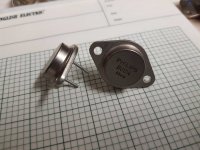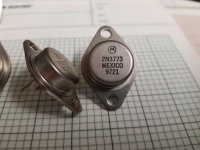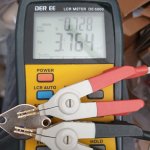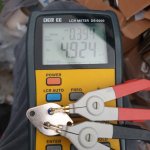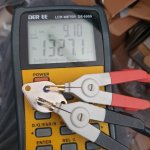I will never forget thousands of burned AU206!
This was my first attempt to repair a black&white SABA t.v receiver.
Problem solved when a real transistor arrived.
Still i keep the bag stamped '' original part''
, the transistor inside was stamped as β206.
This was my first attempt to repair a black&white SABA t.v receiver.
Problem solved when a real transistor arrived.
Still i keep the bag stamped '' original part''
, the transistor inside was stamped as β206.
Date codes by a manufacturer should all be the same. Close enough to make sense out of. Just look up a similar device in production at the time an go from there.
Well if I assume YWW, then "525" could/would be '95, week 25 (or '85 week 25)
Interesting for me, in this thread is the talk of aluminium TO3s, I have a bunch of scrappy looking T03 that are aluminium, and I've not come across them before.
I'd assumed it was a special purpose thing, because the shells dont look all that good, thick strong, compared with steel. That surprises me.
I'd assumed it was a special purpose thing, because the shells dont look all that good, thick strong, compared with steel. That surprises me.
They were strangely light compared to normal transistors. Early three terminal voltage regulators were aluminum too (7805 for example).
Some to3
Here in attached photos are some to3.
Philip's from the 80s (BUS14) extremely thick heavy case, slightly oversize.
Tesla branded 2N3773 from the early 90s, again, heavy case.
Motorola branded 2N3773 from the late 90s, lighter gauge case and pins
The picture I forgot to take was the other Phillips BUS14 I have, with cheap looking case, like the Motorola. (I think some of those Phil's, are fakes - it may be the motorola though, I'd need to test again to refresh my memory.)
Here in attached photos are some to3.
Philip's from the 80s (BUS14) extremely thick heavy case, slightly oversize.
Tesla branded 2N3773 from the early 90s, again, heavy case.
Motorola branded 2N3773 from the late 90s, lighter gauge case and pins
The picture I forgot to take was the other Phillips BUS14 I have, with cheap looking case, like the Motorola. (I think some of those Phil's, are fakes - it may be the motorola though, I'd need to test again to refresh my memory.)
Attachments
These are genuine samples delivered from OmiSemi about 15 years ago
View attachment 958834
View attachment 958835
The MEX bit wrt it being MEXICO is not an indication of fakeness. 🙂
Thank you for your message.I also want to open the top.Is there any easy way?Thanks again.Regards
And mine may be a genuine transistor relabelled as mj15003 too.How to check it? I used alcohol and paper tissue,when rubbing strongly the writing is being erased.
Last edited:
How to open? Grip the top hat with a pair of channellocks and give it a good solid squeeze. If the top pops open immediately, the transistor is fake - period. If all you do is dent the can, use a hacksaw or grinder. F you want to keep it intact for further inspection, just open up a hole and peel the cover back. It may take a while.
Real 15003/4 will have an input capacitance (base-emitter) of at least 4500 pF. Older ones from the 1980’s process may be as low as 3000, but ANYTHING running since the 90’s uses the improved epi-base process which has higher capacitance (and more consistently high low-current hFE - fT remained pretty constant, but ruggedness improved). If it’s a steel can it will have the higher capacitance. I have a bunch of 2N6609’s from Motorola that came from one of the last “runs” ever produced, 1990 date code, from Mouser originally. They measure EXACTLY as modern MJ15004’s, and all my older 1980’s units (mostly aluminum, almost all pulls from equipment) have the lower input capacitance - about 3500 pF. Factor of two difference in 1mA hFE, too. “Second source” 2N6609’s from Mospec (Muticomp, from Newark) measure like the 80’s units from Motorola.
If the lettering comes off, it’s a fake. The $64000 question is what do you have.
Real 15003/4 will have an input capacitance (base-emitter) of at least 4500 pF. Older ones from the 1980’s process may be as low as 3000, but ANYTHING running since the 90’s uses the improved epi-base process which has higher capacitance (and more consistently high low-current hFE - fT remained pretty constant, but ruggedness improved). If it’s a steel can it will have the higher capacitance. I have a bunch of 2N6609’s from Motorola that came from one of the last “runs” ever produced, 1990 date code, from Mouser originally. They measure EXACTLY as modern MJ15004’s, and all my older 1980’s units (mostly aluminum, almost all pulls from equipment) have the lower input capacitance - about 3500 pF. Factor of two difference in 1mA hFE, too. “Second source” 2N6609’s from Mospec (Muticomp, from Newark) measure like the 80’s units from Motorola.
If the lettering comes off, it’s a fake. The $64000 question is what do you have.
The $64000 answer is ... garbage. Discard anything you aren't 100 sure of. It will bite you otherwise.
Here measurements.One of them is mj15004 genuine guaranteed.
Attachments
Last edited:
The first one would be typical of a 1980’s device, with the domed top hat and the old “M” logo - a little low for this type with a 90’s date code or newer. Possible, but not likely. It would at least warrant an SOA test before destroying it to see inside. Well, you can always check to see if the top hat just pops off. The last one would either be a fake, or perhaps a real MJ15015. Send it to the Pit of Despair.
If you find even real MJ15015 or MJ15016, may as well destroy them. They are awful transistors. Even Motorola called them "economy transistors".
Might be fun to blow them in as many ways as you can think of.
-Chris
Might be fun to blow them in as many ways as you can think of.

-Chris
They’re a 2N3055 with Even Less Current Gain. All else being equal, units that have higher Vceo have lower gain. It’s not very high on 3055’s to start with - and I’ve measured hFE of 7 at 5 amps on 15016’s. Where they have the same type graded for voltage, the lower volt version often has higher minimum spec gain. Many of the old epi-base families are that way.
Doesn’t make any sense to buy 15015/6 nowadays, unless you find NOS for less than a buck. And then don’t expect much from them. They cost just as much as 15024’s today. And any old amplifier that calls for them will gladly take 15024’s or 15003’s and the drivers will thank you for it by running 50 degrees cooler.
TO-3’s aren’t as fun to blow up as plastic types. Plug those in the wall and pieces go flying. TO-3 just blows the bond wires, and the explosion is well-contained.
Doesn’t make any sense to buy 15015/6 nowadays, unless you find NOS for less than a buck. And then don’t expect much from them. They cost just as much as 15024’s today. And any old amplifier that calls for them will gladly take 15024’s or 15003’s and the drivers will thank you for it by running 50 degrees cooler.
TO-3’s aren’t as fun to blow up as plastic types. Plug those in the wall and pieces go flying. TO-3 just blows the bond wires, and the explosion is well-contained.
🙂
I've seen holes burned in through the tops of the TO-3 case. Also through the metal cover over the transistors.
Carver PM1.5 that was plugged into a 550VAC circuit. The amplifier didn't survive the experience. I guess we could have rebuilt it, but it needed a new mag coil in addition to the outputs. It was spectacular! Must have been amazing to witness, I just saw and assessed the aftermath.
I've seen holes burned in through the tops of the TO-3 case. Also through the metal cover over the transistors.
Carver PM1.5 that was plugged into a 550VAC circuit. The amplifier didn't survive the experience. I guess we could have rebuilt it, but it needed a new mag coil in addition to the outputs. It was spectacular! Must have been amazing to witness, I just saw and assessed the aftermath.
I’ve burnt holes in the tops of TO’s, by forgetting that the caps were still charged and flipping a PCB over on them. Happened once on a CS800, and it cost me six 15024’s at my expense.
I’ve heard reports of Phase Linear 700’s exploding and even killing people in clubs due to open neutrals. There are some places you shouldn’t trust the power, and those amps are highly unsafe with overvoltage, The most you could get would be 240, and at the typical 150 to 180 you will get they will *try* to run. 550 would probably be like a small nuke going off.
I’ve heard reports of Phase Linear 700’s exploding and even killing people in clubs due to open neutrals. There are some places you shouldn’t trust the power, and those amps are highly unsafe with overvoltage, The most you could get would be 240, and at the typical 150 to 180 you will get they will *try* to run. 550 would probably be like a small nuke going off.
From the looks of things, they sustained an arc. The triac would have changed into a wire instantly, then the mag coil is full on with a large step up. I think the transistor die melted and splashed, creating an arc, then the sustained arc burned through the case top, then the metal cover under it. It seemed like a cutting jet of plasma the way it looked.
The 700s weren't the most stable amplifier anyway. Many brands were the same way, but the Phase Linear sold a lot, so there were many out there to create stories.
I wish I had taken pictures of that Carver!
Any amplifier back then would self destruct with 2X supply voltage. 550 turns them into bombs - or the primary connections blow open. One of the two.
-Chris
The 700s weren't the most stable amplifier anyway. Many brands were the same way, but the Phase Linear sold a lot, so there were many out there to create stories.
I wish I had taken pictures of that Carver!
Any amplifier back then would self destruct with 2X supply voltage. 550 turns them into bombs - or the primary connections blow open. One of the two.
-Chris
“The triac would have changed into a wire instantly” - when they break down or break over, the internal positive feedback turns the gate ON, making it behave as a diode on each half cycle. Most of the time non destructive - but there’s no way to keep one turned OFF with overvoltage. Even at 120 volts applied directly with 180 degree conduction angle those mag coils will saturate and and sound like a beehive till the fuse blows.
- Home
- Design & Build
- Parts
- My Transistors, original or copy?
